
The Gyeongin Line (Gyeonginseon) is a railway mainline in South Korea, currently connecting Guro station in Seoul and Incheon. Commuter services along the line through operates into Seoul Subway Line 1.

Bucheon is a city in Gyeonggi Province, South Korea. Bucheon is located 25 kilometers (16 mi) away from Seoul, of which it is a satellite city. It is located between Incheon and Seoul.

Seoul Subway Line 1 of the Seoul Metropolitan Subway is a rapid transit and commuter rail line which links central Seoul, South Korea to Yeoncheon in the northeast, Incheon in the southwest, and Sinchang via Suwon and Cheonan in the south. The central underground portion of Line 1, running underneath Sejongno, Jongno, and Wangsan-ro avenues along Seoul's traditional downtown area, is the oldest subway-operated section in the Seoul Metropolitan Subway system. Its branches and services cover a large part of the Seoul Capital Area; totaling 218.3 km (135.6 mi) in route length.

Seoul National University Station is a station on Seoul Subway Line 2, located in Bongcheon-dong, Gwanak-gu of southern Seoul. This station is also known as Gwanak-gu Office Station. There are eight exits, two at each corner of the crossroads – of Nambu Beltway (Nambusunhwan-ro) and Gwanak-ro – where the station lies beneath.
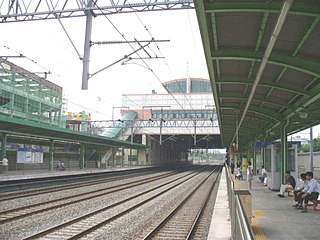
Songtan Station is a ground level metro station in Songtan, a district of Pyeongtaek in Gyeonggi Province, South Korea. The station is on Line 1 of the Seoul Metropolitan Subway, which runs from Soyosan in Dongducheon to Cheonan in Chungcheongnam-do. The line also serves Osan, Suwon, and Seoul.

Ichon Station (Korean: 이촌역) is a station in Yongsan-gu, Seoul on Seoul Subway Line 4 and the Gyeongui–Jungang Line. This station is the closest to the National Museum of Korea, situated in the interior of Yongsan Family Park. It also serves eastern Ichon-dong, home to the largest Japanese community in South Korea with some 1,300 Japanese residents.

Express Bus Terminal Station is a station on Seoul Subway Line 3, Line 7, and Line 9. The stations are located in the Greater Gangnam Area, Banpo-dong, Seocho District, Seoul, Korea.
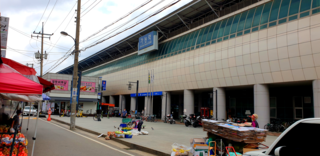
Ganeung Station is a metro station on the Line 1 of the Seoul Metropolitan Subway. The station is located in northern Uijeongbu and previously served as the northern terminus for Line 1 before its extension to Soyosan.

Chang-dong Station is a station on Seoul Subway Line 1 and Line 4. It is located in Chang-dong, Dobong-gu, Seoul. A shopping center was planned for this site, but the empty lot has never been developed due to the bankruptcy of the contractor behind said project. The station is, however, home to a cluster of pojangmacha stalls.
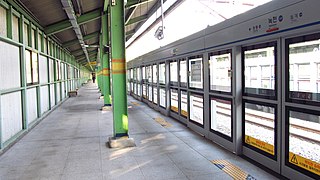
Nokcheon station (Korean: 녹천역) is a metro station on Seoul Subway Line 1 in South Korea. It is located in the northern end of the city.

Soyosan Station is a ground-level metro station on Line 1 of the Seoul Subway in Sangbongam Dong, Dongducheon, South Korea. It is named after the nearby Soyosan (587 m), a mountain beside the U.S. Army base Camp Casey. It is on this mountain, at the Jajae'am Hermitage, that the Buddhist Saint Wonhyo is said to have reached enlightenment.
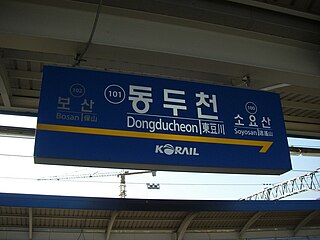
Dongducheon Station is a metro station located in Dongducheon, South Korea. Seoul Subway Line 1 serves this station, and it is the terminus station for Gyeongwon Line express trains. Camp Casey, a U.S. Army military base, is located nearby.

Bosan Station is a subway station located at Dongducheon, Gyeonggi-do, South Korea. This station is on the Seoul Subway Line 1. Camp Casey, an American military base, is located nearby.
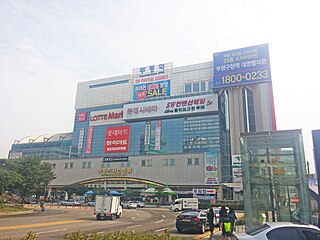
Bupyeong station is a subway station located in Bupyeong District, a district in Incheon, South Korea. This station is on the Seoul Subway Line 1 and Incheon Subway Line 1. It is one of the busiest stations on the Incheon line because of its central location and its connection to the Seoul line.

Dongducheon Jungang Station (Korean: 동두천중앙역) is a train station on the Seoul Subway Line 1 and the Gyeongwon Line. The name means Dongducheon Central Station. It was also once known as Eosu-dongStation.
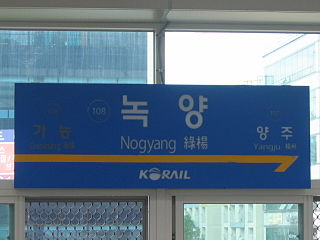
Nogyang Station is a station on the Gyeongwon Line in South Korea. It is served by Seoul Subway Line 1. The station lies in the far northern end of Uijeongbu in Gyeonggi-do.

Yangju Station is a train station on Seoul Subway Line 1 and the Gyeongwon Line. The name comes from Yangju, the city where this station is located. Until December 2007, it was called Junae Station.

Deokgye Station is a train station on Line 1 of the Seoul Subway. It opened in December 2007.

Deokjeong Station is a station in Seoul Subway Line 1. On October 15, 1911, the service started. In 2006, it started to operate the metropolitan train.

Juan station is a subway station on the Seoul Metropolitan Subway Line 1 and Incheon Subway Line 2. This station receives the second-highest number of crowds along the entire Incheon line due to its proximity to the downtown area. It is also near Inha University and Inha Technical College.





















